
Mackerel is a common name applied to a number of different species of pelagic fish, mostly from the family Scombridae. They are found in both temperate and tropical seas, mostly living along the coast or offshore in the oceanic environment.

The zebra moray is a species of marine fish in the family Muraenidae. It is the only member of the genus Gymnomuraena, though it sometimes has been included in Echidna instead.
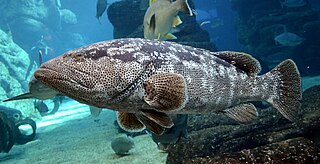
The Malabar grouper also known as blackspot rockcod, estuary rockcod, giant rock cod, greasy grouper, Malabar rockcod, Morgan's cod or speckled grouper, is a species of marine ray-finned fish, a grouper from the subfamily Epinephelinae which is part of the family Serranidae, which also includes the anthias and sea basses. It is found in the Indo-Pacific region. It has entered the Mediterranean Sea from the Red Sea by way of the Suez Canal as a Lessepsian migrant.
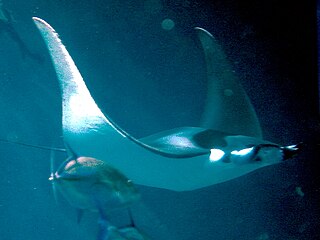
The spinetail devil ray, also known as the spinetail mobula ray or Japanese mobula ray, is a species of pelagic marine fish which belongs to the family Mobulidae. It is found throughout the tropical and sub-tropical waters of the Indo-Pacific and eastern Atlantic Ocean.
Sphoeroides trichocephalus, the pygmy puffer, is a species of marine pufferfish native to the Central American coast of the Pacific Ocean, and can be found from La Serena, Chile to San Carlos, Mexico. S. trichocephalus are a demersal species, commonly found on soft substrates in shallow bays and coves at depths between 1–10 m (3.3–32.8 ft). This species grows to a maximum total length (TL) of 10.5 cm (4.1 in). They are not widely utilized by humans but may be found in markets sold as a food fish. They are likely taken as bycatch in trawl fisheries and discarded.

The mackerel scad, or speedo, is a species of fish of the family, Carangidae. While it can be considered gamefish, it is usually used as bait. It is popular for consumption in Hawai'i, the Philippines and the U.A.E. In Hawai'i, mackerel scad are called ʻopelu. In the Philippines they are called galunggong.

The round scad is a species of fish in the Carangidae. It was described in 1829 by the French naturalist and zoologist, Georges Cuvier. Although the round scad is considered a good food fish, it is mostly caught for use as bait.
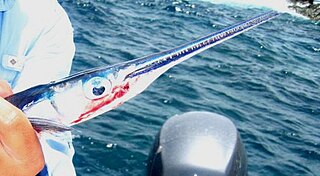
The flat needlefish, or barred longtom, the only known member of the genus Ablennes, is a marine fish of the family Belonidae. Flat needlefish are considered gamefish, frequently caught with the help of artificial lights, but are not often eaten because of their green-colored flesh.
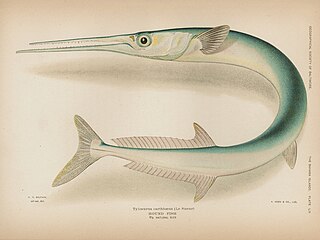
The houndfish is a game fish of the family Belonidae. It is the largest member of its family, growing up to 5 feet (1.5 m) in length and 10 pounds (4.5 kg) in weight. It is also often called the crocodile needlefish.

An anchovy is a small, common forage fish of the family Engraulidae. Most species are found in marine waters, but several will enter brackish water, and some in South America are restricted to fresh water.
The Pacific bumper is one of two game fish in the genus Chloroscombrus, from the subfamily Caranginae of the family Carangidae, part of the order Carangiformes.
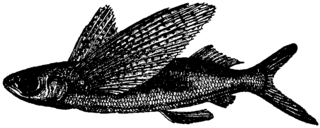
The ornamented flying fish, or beautyfin flying fish, is a species of flying fish of the genus Cypselurus in the family Exocoetidae. The British ichthyologist Albert Günther first described it in 1866 in his eight-volume Catalogue of Fishes (1859–1870).

Fistularia corneta, commonly known as the Pacific cornetfish or the deepwater cornetfish, is a marine fish in the family Fistulariidae. It is endemic to the eastern Pacific Ocean, being found from California to Peru, including many offshore islands. Adult fish are found deeper than 30 metres (98 ft) and have been observed to grow longer than 1 metre (3.3 ft), but are more commonly around 20 centimetres (7.9 in) long. F. corneta feeds on small fishes, and itself is most commonly used by humans as processed fishmeal, which can be marketed as fresh, salted or dried. It is an oviparous species.
Pomadasys macracanthus, the longspined grunt or Mexican gray perch, is a species of marine ray-finned fish, a grunt belonging to the family Haemulidae. It is native to the Eastern Pacific from Mexico to Ecuador.
Halichoeres malpelo, or the Malpelo wrasse, is a species of saltwater wrasse found in the Eastern Central Pacific Ocean.
Halichoeres insularis, or the Socorro wrasse, is a species of saltwater wrasse found in the Eastern Central Pacific Ocean.
Diaphus suborbitalis is a species of lanternfish found in the Indo-Western Pacific Ocean.

Physiculus talarae, the Peruvian mora, is a species of bathydemersal fish found in the eastern Pacific Ocean.
Physiculus nematopus, the charcoal mora, is a species of bathydemersal fish found in the eastern-central Pacific Ocean.












